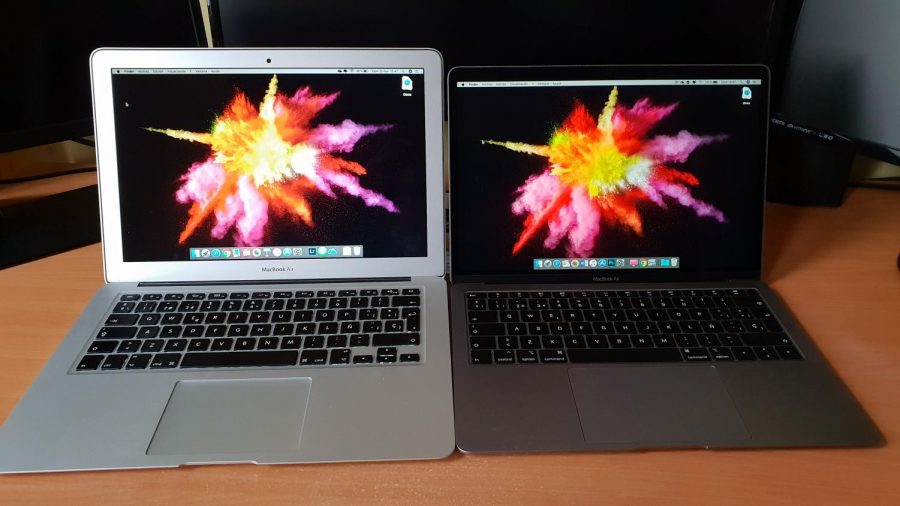Fresh Air: Old Laptop v. New Laptop
Everyone knows that the freshmen have the best laptops; they are thin, light, space-grey, and carry the highest price tag of any Air product, ringing in at $1,199. But are these laptops worth the cost? Apple thinks so. Let’s look at why:
The Physical Computer
The new Air is smaller, thinner (15.6mm thin), and lighter (weighing 2.75 pounds, a quarter of a pound less than the previous model, thus sparing freshmen’s backs for a few months longer). While our freshmen only see it in space grey, the new Air also comes in silver and gold.
Improved Retina Display
While the screen size remains at 13.3 inches, its resolution of 2,560 x 1600 is almost double the old Air’s resolution of 1,440 x 900. Furthermore, its display glass runs as close to the edge of the enclosure as possible (.3 inches wider) and its borders are 50% thinner than that of the old Air.
The screen also has 48% more colors than the past version, meaning more variations in the RGB color scale by increasing the number of bits used to store the color shades, which makes images more vibrant. This would make the biggest difference for artists; however, for the average user, this change may not carry much value.
Apple also implemented “True Tone” in the new Air (among other new devices) which changes the white balance of the display to appear the same to the user, no matter what environment they are in by matching the environment’s light scheme.
True Tone may improve the sleep health of the user because it minimizes the amount of blue light exposure, which may result in better quality sleep (see Harriton Needs Sleep and Here’s Why). True Tone is also particularly helpful to artists, who might want to work on a piece in multiple locations without having the colors distorted when they change locations.
The Apple Security T2 Chip
The T2 chip enables “Hey, Siri” capabilities and enhances security during storage and booting up by providing “on-the-fly data encryption” for everything on the drive.
The Newer Butterfly Keyboard
In 2017, Apple switched from the scissor-switch mechanism keyboard, where two plastic rods that interlock like scissors snap the key to the keyboard, to the butterfly mechanism, which instead joined the pieces at the center in a butterfly-like fashion. The intention of the change was to increase keyboard stability by making it 40% thinner.
This change, however, produced a barrage of criticism, as many found that the keyboard actually increased errors, was louder, and was less durable than the scissor-switch keyboard. With the new Air, Apple hopes to make the keys more stable, quieter, less failure-prone, more comfortable and more responsive.
The Larger Force Touch Trackpad
The Force Touch Trackpad is 20% larger than the previous trackpad, leaving more room for Multi-Touch gestures.
The Internals
The heart of the laptop includes an 8th generation Intel Core i5 processor, up to 1.5 TB of SSD storage, and up to 6 GB of RAM. Apple also claims up to 12 hours of battery life (compared to up to 10 hours for the 2017 Air), which many upperclassmen may envy after seeing that dreaded “low battery” alert during class and not having a computer charger.
The Thunderbolt 3
While Apple still does not offer an SD slot or a USB-A port, the USB-C port that the Air sports allows universal functions, including data transfer, charging, and video output, while also supporting the Thunderbolt 3 in faster data-transfer speeds.
Materials
Greta Thunberg and other environmentalists may be jumping with joy over this new feature: the new Air is the first MacBook that is composed completely of recycled aluminum which has been separated into shavings and re-engineered at the atomic level. Without decreasing the quality of the Air, this technique has allowed Apple to reduce carbon emissions by 47% from those of the previous model, creating the greenest Air so far and helping to promote cleaner air.
Other Updates
The new Air comes with a slew of new apps for music, TV, and podcasts, new features in the apps, and “Sidecar,” a technology that allows the user to pair an iPad with their Air to use the iPad as a secondary Mac display.
The Bottom Line
Ultimately, the new MacBook Air comes with an abundance of new features that will improve the learning environment and ease of information acquisition for our students. Are all these perks worth the price? That is for each individual to decide.
However, having any laptop at all is an occasion for gratitude, as these devices bring a rich and creative learning environment right to our fingertips.
One thing is certain: in the silent glow of my current 2017 Air’s blue light, I have percolated creative ideas, collaborated with classmates into the late hours of the night, stayed connected to my peers through swirling winter snowstorms and celebratory spring breaks, and frantically pounded out my share of final papers, thesis outlines, and study notes. So if you will excuse me, I will now tap on my crumbling keyboard and finish out this article for The Banner.

Anya Jayanthi '21 is thrilled for her fourth year with The Banner! As a co-editor for the S&T section, she hopes to continue exploring the greater...


